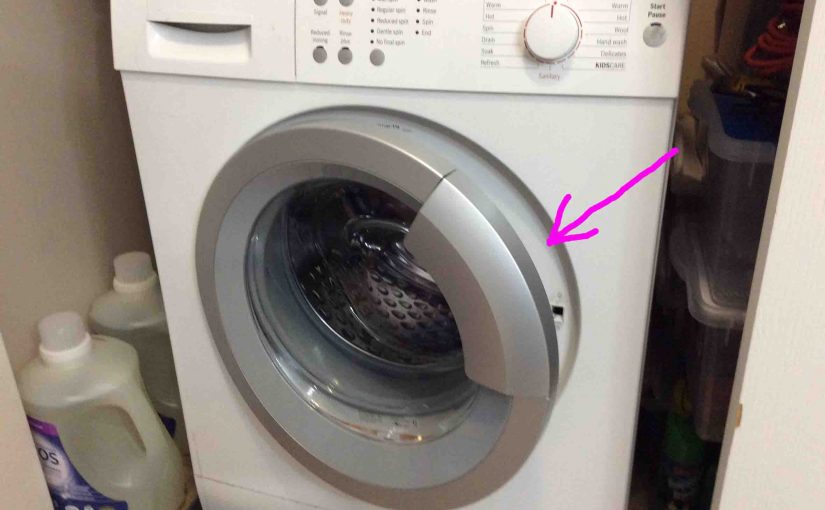For both top loader and front loader washing machines, HE and traditional, the ways to clean any smelly clothes washing machine, work about the same. At first. Why? Because they all get rid of the foul, musty mildew, rotten eggs, sulfur, and other weird odors. But some cleaning techniques keep odors away longer. We discuss these below.
How to Clean Smelly Washing Machine Intro
The bleach and commercial washer cleaner products below may offer more lasting freshness protection. But the baking soda and white vinegar may be less hard on the machine’s water-handling parts. Indeed, some washing machine builders advise against using chlorine bleach. Plus, bleach may also damage the clothes if not fully rinsed from inside the washer. So, clean with bleach at your own risk.
But there are many products to get rid of that moldy, musty, damp mildew smell out of a stinky washer. These address the causes of these smells, while at the same time, are gentle on machine parts and clothes. So, we suggest first trying the commercial products. E.g. Gain, Tide, or Affresh washing machine cleaners. Then, if you’re hard pressed for money, try the bacon soda and vinegar method. Finally, as a last resort, try deodorizing the washer with bleach.
The commercial products and bleach work very well to disinfect the washing machine. But the while the white vinegar and baking soda mix is very cheap and safe to apply. It will not harm clothing.
Remove All Clothes from Washer
Always make sure that the washer drum is empty before you start cleaning. Any of these techniques might damage or discolor clothes left inside.
Clean that Filter!
With so equipped washing machines, check the water filter each time you freshen your washer. This assures that no lint, threads, small cloth pieces, or other clothing clog the filter. These cloth pieces trap moisture. Further, they can remain soaking wet for days after the washer’s last use. Indeed, a chronically wet filter can generate quite a damp, musty smell. Plus, it also shortens the amount of time that your washing machine will smell fresh after deodorizing. So to get the most bang for your washer-cleaning buck, clean that filter often!
1. Clean Smelly Washing Machine with Baking Soda and White Vinegar
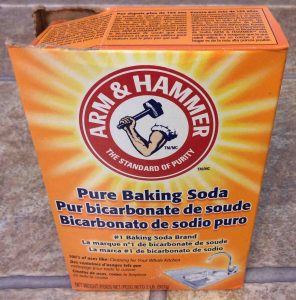
1-1. Wipe Visibly Dirty Surfaces Clean
Visible build up of smelly dirt and growth is often hard to clean. E.g. Find these around the seals, gaskets, mating surfaces, and inside the drum. So to get at them, wipe these places with a white vinegar and water mix. Use a half vinegar and half water mix.
1-2. Add the Vinegar and Baking Soda
To clean, mix a half-cup of baking soda with a half-cup of water, and fill the soap dispenser with this. Then, pour two cups of white vinegar directly into the washer tub.
1-3. Run the Washer on Regular Cycle, Hottest Water
Close / latch the door and run on REGULAR wash cycle, using HOT water. Do not here, use the SANITIZE, CLEAN, or AFFRESH cleaning cycles; just REGULAR.
1-4. After the Cycle Completes
Your washer is now deodorized. The vinegar has likely killed most odor causing germs, and the baking soda has eliminated the musty odors.
2. Clean a Smelly Washing Machine with Bleach

Sterilizing your washing machine with bleach is a highly effective, economical way to deodorize it. But too much bleach can damage some machine parts. Plus, spilling it can damage floors and clothes as well as irritate the skin. Further the smell of chlorine can get quite strong during the cycle. So bleach is a last resort for us in keeping our machine sparkling clean and odor free.
But some folks like the strong bleach smell during cleaning. So they don’t mind the risks. They should read the manual for their washing machine, to find out if laundering with bleach is okay. If not, then DO NOT use bleach. This could result in costly washer repairs.
2-1. Use More Bleach for Dirtier Washers
For stubborn odors or visible build up of smelly dirt and growths, use a half-cup of bleach. Bleach often loosens and removes mold and mildew.
2-2. Add the Bleach
To clean, drop one quarter cup directly into washer tub. Do not put in the soap dispenser. We also suggest that immediately upon bleach application, that you start the washer a going. You don’t want concentrated bleach sitting the washtub for any longer than necessary.
2-3. Run a Regular Wash Cycle, with Hottest Water
Close / latch the door and run the washer on the REGULAR wash cycle, using HOT water. We suggest not using the CLEAN cycle in the bleach case. Why? Because heated bleach can smell quite strong and take a long time to go away.
2-4. Afterwards, Rinse!
After the regular wash cycle finishes, run it again through a regular cleaning cycle with hot water. But this time, add no cleaner. This assures that any last drops of bleach inside rinse away. That way, they will not discolor or damage your clothing the next time you do laundry.
3. Clean a Smelly Washing Machine with These Products
We’ve successfully deodorized our clothes washers with the products shown next. Using these thus, is our preferred method of stopping washing machine odors. See our posts about each one for more details by following the picture links.
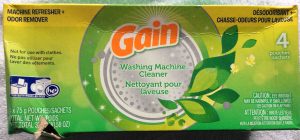
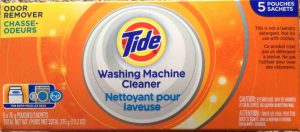
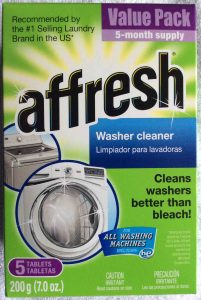
We follow the routine below when using these store-bought washing machine cleaners.
3-1. Pay Attention to All Cautions and Warnings
Follow the manufacturer’s directions first, printed on the box of the product you’re using. But if you find that they don’t work as well as you’d hoped, then try the following steps.
3-2. Use the SANITIZE Cycle to Clean a Smelly Washing Machine
If your washer has one, and it’s not forbidden by your choice of machine cleaner. This cycle often works quite well. Why? Because average washers heat the water to greater than 160 degrees F while cleaning themselves. This temp is much hotter than the hot water from your tap. So the washer heated water works better at killing more of those odor-causing germs inside.
3-3. Remove All Clothes from Washer First
Never run your machine through a cleaning cycle with clothes in the tub. The garments might be damaged by the machine cleaning agents, and the cleaning might not work fully.
3-4. Add the Cleaner
To clean, drop ONE tablet, or empty one pouch, directly into washer tub. Do not place in the soap dispenser. Putting the cleaner directly into the laundry tub keeps the chemicals in it from harming the soap dispenser.
3-5. Start the Cleaning Cycle
Close / latch the door and run on the SANITIZE, CLEAN, or AFFRESH cleaning cycle. High efficiency washers usually offer this specialized cleaning cycle. Bear in mind though, that some cleaners want you to run them through the REGULAR cycle instead of SANITIZE. If that’s true of your cleaner, then do as they say.
3-6. Open Hatch and Let Washer to Dry Inside
3-7. The Smelly Washing Machine is Now Clean!
4. To Help a Smelly Washing Machine Stay Clean
4-1. Always Air Out your Washer
To avoid odor return, let door stand open between washer uses. This allows complete and fastest drying of the tub, seals, hoses, hinges, pumps, and related parts.
4-2. Wash Bleach Loads Last
If you wash bleach loads, make them the last loads you do in a laundry session. This way, the bleach will kill many odor-producing bacteria and germs. This also helps keep the washer odor free for more weeks.
4-3. Use a Good Laundry Soap
High efficiency washing machines demand laundry detergent that is specifically formulated for them. These laundry soaps sport the HE symbol somewhere on the front label. HE soaps also minimize detergent residues that accumulate faster with high sudsing detergents. HE detergents produce very low soapsuds, and thus, much less residue buildup in the washer over time.
4-4. Repeat Once a Month or As Needed
Disinfect your washing machine at least once per month. But you may need to deodorize more often. E.g. Like when you do laundry so often that the machine never completely dries out between loads.
Related Posts to How to Clean Smelly Washing Machine
- How to Clean Front Loading Washing Machine with Bleach
- Affresh Laundry Machine Cleaner Review
- Tide Washing Machine Cleaner Review for HE
- How to Clean Front Loading Washing Machine with Bleach
- Front Loader Washing Machine Pros and Cons
References for How to Clean Smelly Washing Machine
Revision History
- 2019-07-21: Added key word targeting for ‘Clean Smelly Washing Machine’. Removed ad script code, and added in more tags and links.
- 2017-01-30: Originally published.
